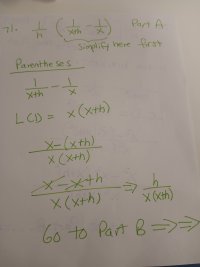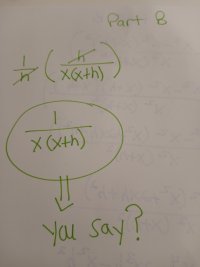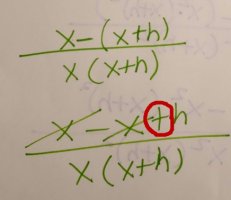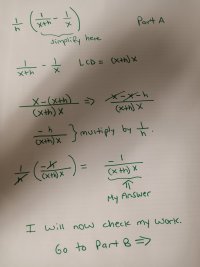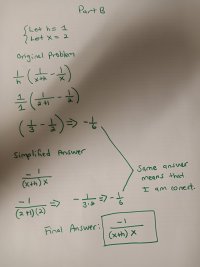You are using an out of date browser. It may not display this or other websites correctly.
You should upgrade or use an alternative browser.
You should upgrade or use an alternative browser.
Simplify Rational Expression...2
- Thread starter feliz_nyc
- Start date
Copy.
We are happy to help, but you should learn to check your own work and find your own errors. For one thing, it will greatly increase your confidence that you have grasped a subject.
How do you check a simplification of an algebraic expression?
Pick an example using numbers that are small in magnitude but greater than |1|.
Here we have an expression in two variables. Let x = 2 and h = - 5.
[math]\dfrac{x - (x + h)}{x(x + h)} = \dfrac{2 -(2 - 5)}{2(2 - 5)} = \dfrac{2 - (-3)}{2(-3)} = \dfrac{5}{-6} = - \dfrac{5}{6}.\\ \dfrac{h}{x + h} = \dfrac{-5}{2 - 5} = \dfrac{-5}{-3} = + \dfrac{5}{3}.\\ -\dfrac{5}{6} \ne + \dfrac{5}{3}.[/math]
You may occasionally pick an example that is accidentally correct although the simplification is wrong in general. (This happens most often with 1, 0, and -1, which is why not to use them in examples.) But 99 times out of 100, an example will tell you if a simplification is not correct.
How do you check a simplification of an algebraic expression?
Pick an example using numbers that are small in magnitude but greater than |1|.
Here we have an expression in two variables. Let x = 2 and h = - 5.
[math]\dfrac{x - (x + h)}{x(x + h)} = \dfrac{2 -(2 - 5)}{2(2 - 5)} = \dfrac{2 - (-3)}{2(-3)} = \dfrac{5}{-6} = - \dfrac{5}{6}.\\ \dfrac{h}{x + h} = \dfrac{-5}{2 - 5} = \dfrac{-5}{-3} = + \dfrac{5}{3}.\\ -\dfrac{5}{6} \ne + \dfrac{5}{3}.[/math]
You may occasionally pick an example that is accidentally correct although the simplification is wrong in general. (This happens most often with 1, 0, and -1, which is why not to use them in examples.) But 99 times out of 100, an example will tell you if a simplification is not correct.
We are happy to help, but you should learn to check your own work and find your own errors. For one thing, it will greatly increase your confidence that you have grasped a subject.
How do you check a simplification of an algebraic expression?
Pick an example using numbers that are small in magnitude but greater than |1|.
Here we have an expression in two variables. Let x = 2 and h = - 5.
[math]\dfrac{x - (x + h)}{x(x + h)} = \dfrac{2 -(2 - 5)}{2(2 - 5)} = \dfrac{2 - (-3)}{2(-3)} = \dfrac{5}{-6} = - \dfrac{5}{6}.\\ \dfrac{h}{x + h} = \dfrac{-5}{2 - 5} = \dfrac{-5}{-3} = + \dfrac{5}{3}.\\ -\dfrac{5}{6} \ne + \dfrac{5}{3}.[/math]
You may occasionally pick an example that is accidentally correct although the simplification is wrong in general. (This happens most often with 1, 0, and -1, which is why not to use them in examples.) But 99 times out of 100, an example will tell you if a simplification is not correct.
You are right about checking my own work. I will work this problem out again later and check my work.
We are happy to help, but you should learn to check your own work and find your own errors. For one thing, it will greatly increase your confidence that you have grasped a subject.
How do you check a simplification of an algebraic expression?
Pick an example using numbers that are small in magnitude but greater than |1|.
Here we have an expression in two variables. Let x = 2 and h = - 5.
[math]\dfrac{x - (x + h)}{x(x + h)} = \dfrac{2 -(2 - 5)}{2(2 - 5)} = \dfrac{2 - (-3)}{2(-3)} = \dfrac{5}{-6} = - \dfrac{5}{6}.\\ \dfrac{h}{x + h} = \dfrac{-5}{2 - 5} = \dfrac{-5}{-3} = + \dfrac{5}{3}.\\ -\dfrac{5}{6} \ne + \dfrac{5}{3}.[/math]
You may occasionally pick an example that is accidentally correct although the simplification is wrong in general. (This happens most often with 1, 0, and -1, which is why not to use them in examples.) But 99 times out of 100, an example will tell you if a simplification is not correct.
Attachments
jonah2.0
Full Member
- Joined
- Apr 29, 2014
- Messages
- 534
Beer induced opinion and suggestion follows.
Since this is an odd numbered exercise (#71 as you indicated), you might have saved yourself some trouble by simply peeking at the answers section and figured out for yourself were you might have gone wrong. That said, to paraphrase SK, it (your final answer) looks good.College Algebra
Chapter 1/Section 7
Yes, you got the correct answer, but two points.
First, an example never guarantees that you are correct. It strongly suggests that you are correct.
Second, try to avoid 1, 0, and - 1 as exemplars. Those numbers have special properties that have a higher than usual liklihood of giving a misleading example.
First, an example never guarantees that you are correct. It strongly suggests that you are correct.
Second, try to avoid 1, 0, and - 1 as exemplars. Those numbers have special properties that have a higher than usual liklihood of giving a misleading example.
I'll remember that for next time.Yes, you got the correct answer, but two points.
First, an example never guarantees that you are correct. It strongly suggests that you are correct.
Second, try to avoid 1, 0, and - 1 as exemplars. Those numbers have special properties that have a higher than usual liklihood of giving a misleading example.
Yes, thanks for reminding me to answer odd number questions. I can search the answer section in the back of the texrbook to see if I am right or wrong.Beer induced opinion and suggestion follows.
Since this is an odd numbered exercise (#71 as you indicated), you might have saved yourself some trouble by simply peeking at the answers section and figured out for yourself were you might have gone wrong. That said, to paraphrase SK, it (your final answer) looks good.

